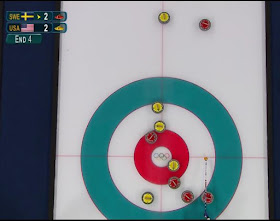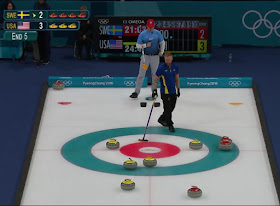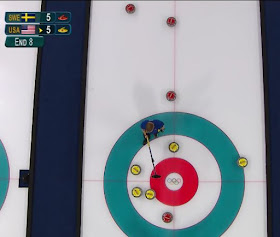Curling is a sport (yes, it is) that involves big muscles for sweeping, small muscles for precision and one big gray blob that’s sort of a muscle and fits between your ears. In a game where finesse is required, adrenaline and nerves can impart the smallest change to the delivery or release of a stone and result in a miss. The re-introduction of curling to the Olympics (officially) in 1998 and the growth of sponsorship and televised events has led players and teams to raise their level of play the past two decades. Shot making has improved considerably, but also mental preparation and the ability for teams to be more consistent and reach their potential despite the enormity of the moment. But it’s still sports.
The clearest example of mental control driving small muscles is golf. How can Scott Hoch miss a 2 foot putt that he makes on a practice green (or at another event) 100 times out of 100? Because he’s on the 10th hole at Augusta National, in a sudden-death playoff, attempting to win a green jacket. Twenty years later, Kenny Perry birdies the 16th hole, then hooks his next two drives leading to consecutive bogeys and loses the Masters. Canadian curling fans may remember one of its greatest players, Kevin Martin, had a similar collapse on the very same day as Kenny. In control and tied with final rock in the last end against Scotland, Team Martin gets into a hot mess. Kevin inexplicably decides to throw away his first skip shot of the end, misses his last, and hands David Murdoch the World Championship.
John Shuster deserves every accolade in the coming weeks and months. Being a curler, he’ll likely be the first to remind everyone that he couldn’t have done it without the team (Tyler George, Matt Hamilton and John Landsteiner). Unlike football, where an NFL quarterback receives $20M per year, while being protected by lineman making $1M a year, curlers share their winnings equally. You can make the argument that Canada in the semifinal and Sweden in the Gold medal game, both lost because they played poorly. This is unfair to Team Shuster. Championships are rarely about two teams who play their best and the better (or luckier) wins. As often as a sporting event will unfold by the script we expect (2012 Heat, 2017 Warriors, most Yankees championships), often we see the opposite. Just this past decade we have the 2011 Mavericks, 2012 Kings, 2014 Giants, 2012 Ravens, and 2018 Eagles; all teams Vegas pegged as longshots before their respective playoffs began. Isn’t that why we watch?
If Canada had performed to their highest level, USA would likely have played for a bronze medal. What John Shuster and his team showed was the ability to play their very best when it mattered. Despite the early setbacks (2-4 start) and even later ones (see 5th end vs Sweden), they held together mentally and when the dust had settled, earned the (women’s) Gold medals. I don’t think you can argue that Team Shuster took advantage of their underdog position. We often overlook a team or player succeeding because they were loose, playing like they had “nothing to lose”. John Shuster only had the scrutiny of an entire nation, a high-performance program that rejected him and his name coined as a verb for failure. Players and teams often have to lose one or more times before they can attain the next level. The list is long and includes the 1983 Oilers, ’85 Giants, ’03 Red Sox, Tom Watson, Mike Weir, Jordan Spieth…and curlers like Al Hackner, Pat Ryan, Kevin Martin, and possibly anyone who has every laced up sneakers, skates, spikes, or a slider. Some never return to those moments again, the many battle scars actually prevent rather than enable the person to rise above their past disappointments. After six games, it looked like John Shuster might suffer that fate. Thankfully, for him and his team, and the (now growing) number of fans, the summit was reached.
On to the analysis….
First End: 0-0 - SWE has Hammer
Edin was 101-22 starting with hammer the past 2 seasons, including 47-6 in his last 54. Two of those loses however, came from Team Shuster. This USA team had actually beaten Edin in 3 of the previous 4 games, so if there were any nerves it wasn’t because they lacked confidence against their opponent.
First rock goes in, Sweden hits, and the blank is on. Now everyone can breathe a little.
Second End: 0-0 - SWE has Hammer
Centre guard then corner guard, game on. On his first, John considers going around the centre, but decides to hit the Swedish rock at the back of the rings.
USA is yellow
As John might have suspected, Niklas ignores the USA rock and goes around, biting the top four foot.
John’s original call looks conservative, avoiding any chance of three but possibly increasing the chance for a deuce. In retrospect, if Shuster had instead gone behind the centre where Edin placed his stone, he could have pressured Niklas early in the contest and gotten a force of a single point or possibly a steal. If he made a poor shot on his first and Edin makes a great shot, worst case he can remove the back stone on his last shot and concede the deuce, avoiding the three in either case. John may have been thinking further ahead, wanting to play the runback on his final stone, attempting to stick it behind cover of his delivered rock or the red corner guard. Runbacks look difficult, but top players range from 75-85% success and often use it as an offensive weapon in the modern game. I prefer John draws on his first shot because he can dictate the proximity to the button and increase a steal chance, but it’s more a preference of setting up his last shot than a tactical mistake. In this case, John misses the runback and Sweden draw for two points.
In the last 4 years, Niklas Edin up 2 points without hammer and 8 ends remaining: 16-1.
Third End: 2-0 SWE - USA has Hammer
A plan B split by Matt Hamilton sets up a potential deuce.
They even comment afterwards it might be the better outcome. An example of how a team can ignore an opponent’s rock(s) sitting shot and make a play elsewhere to set-up for the rest of the end. If Matt’s shot had gone around the guard instead, play would be towards the middle and if rocks aren’t positioned well, Shuster may end up chasing with runbacks later, just to score a single.
Eventually, Edin rolls too far on his last shot and Shuster is left with a long double takeout for two points. A key shot that if thrown a fraction off could hand Sweden a point. The usual miss is to hit the first rock too thick and get a single, a common result under pressure. John nails it.
Shuster smiling after making the shot of his life...for now
Fourth End: 2-2 - SWE with Hammer
Half the end is over and every rock is in play…
And John looks like a man working out a geometry problem…
" Hmm. Squareroot of the long side of the triangle and carry the 2..."
An interesting end with too much discussion for me to cover. I suggest you find a link (depends on which country you are in) and re-watch the entire 4th end. If you’re in Canada, here’s a link to the CBC and for those of you in the US, NBC. I would show these final eight shots to anyone who wants to understand the appeal of curling.
Arguably both teams struggle getting rocks placed to their advantage and before Swedish third Oskar Eriksson’s shot we get a long discussion with he and Niklas that reminds me of this famous Swede. Yes, I know, it’s poor taste in humour, poking fun at the language of Scandinavian people steeped in culture and history…but who doesn’t love the Muppets?
Niklas misses his first shot, leaving USA an opportunity. A great example of body language from the Shuster squad as John sits in the hack. Tyler yells out to tell John the weight and Matt barks back “even if I’m wrong?”. Smiles and laughter from everyone involved. You can tell this team is enjoying the moment. Unfortunately John is a touch heavy, the rock stays straighter and they leave Edin a shot for his deuce. Sweden likely didn’t have a chance at two points before John threw it.
This is just like...
...those spot the difference games.
In what is possibly the shot of the game, Edin’s double attempt also hangs out and when all the granite has stopped, a measurement leaves USA with a steal of one.
Difference for Sweden, their Win Probability (WP) dropped from 75.1% (2 up without hammer) to 41.5%.
Fifth End: 3-2 USA - SWE with Hammer
After Tyler's first rock it appears USA is in good shape.
Sweden still has hammer and Niklas is looking at ways to get two but also ensure he leaves himself an escape plan for his final shot to get one. Before Tyler’s next shot, the Shuster squad ponders how not to leave Sweden a triple or quadruple. It seems unlikely, but against this team, you can never be too careful.
What to do...what to do...
On John’s first, the guard is too high and leaves Niklas a draw to get out of the end. It’s a touch heavy and overcurls, leaving John a chance follow him down, lock his final stone on top and possibly steal. He’s heavy. Tyler in fact, yelled down that it’s ok to be a little heavy and push the Swedish stone back. Maybe a poor choice of words as John does throw it heavy, it runs straight and slides past the rock entirely. Niklas has a draw to the full four foot and makes it for his two points.
Sixth End: 4-3 SWE – USA with Hammer
Edin misses a runback on his first shot, allowing Shuster a chance to sit two. Difficult to find a spot that won’t leave a double, but they are able to draw close to the Swedish stone at the back of the rings in an ideal position. An example of how rock placement is critical.
No double to see here
Niklas only has a hit and roll on John’s stone at the back, hoping to duck behind cover over the USA stone at the top eight foot and leave a more difficult shot for two. It overcurls and John is left with a draw for two. WP for USA jumps from 35.6% if they had been forced to one to 60.4% with that extra point.
Seventh End: 5-4 USA – SWE with Hammer
After Swedish second Rasmus Wrana comes short with his second shot, the house again looks favourable for USA.
A few shots later, Shuster comes deep with a guard attempt on his first, and Sweden attempts a hit and roll, hoping to sit second and third and possibly also graze their red stone top button with the top yellow rock.
Niklas sets it back (a subtle motion in the release to move the rock off line) misses all but a rub on the red stone, leaving the same mess he had before.
USA places a guard and Niklas has to make a double raise on two yellow stones to get his single.
Eighth End: 5-5. USA with Hammer
Three ends to go and USA is in a great position (WP=64.4%). Sweden manages to place two centre guards. Lead John Landsteiner, who missed a tick attempt on his first places his next perfectly.
Matt’s second stone rubs a long centre guard but luckily continues towards the house, curling in at the last second at almost 3 o'clock for a biter.
Sweden has a lonely shot stone at the back of the four foot with USA sitting 2nd, 3rd and 4th. This is an example of the right way to miss a shot. Edin replaces the centre guard, but fails to cover their shot stone.
Shuster has a decision between whether to continue peeling guards or going into the rings. They switch to aggressive play, attempting a hit and roll on the red stone behind the button. The rock overcurls, jamming the Swedish stone at the back, however USA sits two.
In what may have been another shot of the game, Oskar’s draw attempt rubs the yellow in the top eight foot, leaving his stone open rather than buried on the button.
That fraction of an inch is the difference between a possible steal or force and what happens next.
Tyler fails to make the double, but his shooter sticks around and USA sits 1,2,3 and 5. Notice that there have been several half shots by USA but Sweden is going for broke at this stage and can’t dare switch to damage control trying to remove these stones. A deuce by USA would drop Sweden’s WP to 13.7%. It’s force, steal or a prayer at this stage.
Edin’s first draw attempt hangs straight and Shuster is able to hit and roll away. Before his last, Niklas calls a timeout, looking at this:
"And you may ask yourself, well...How did I get here?" - David Byrne
The hit and roll attempt fails to get behind cover and USA is left with a double for five points. Here’s the link on NBC. Shuster calmly makes the shot of his life and the game is, (for all intents and purposes) over. Gold medal. Well done.
Epilogue: Will this launch Curling to new heights in the USA? Probably not. But it can’t hurt. In the very least, perhaps Urban Dictionary will direct the web link for “Shuster” to a new word, “Miracurl”. Definition: "an unheralded person or team, holding brooms, achieves the unexpected on a sheet of ice, painted with rings and covered with granite stones."



















No comments:
Post a Comment